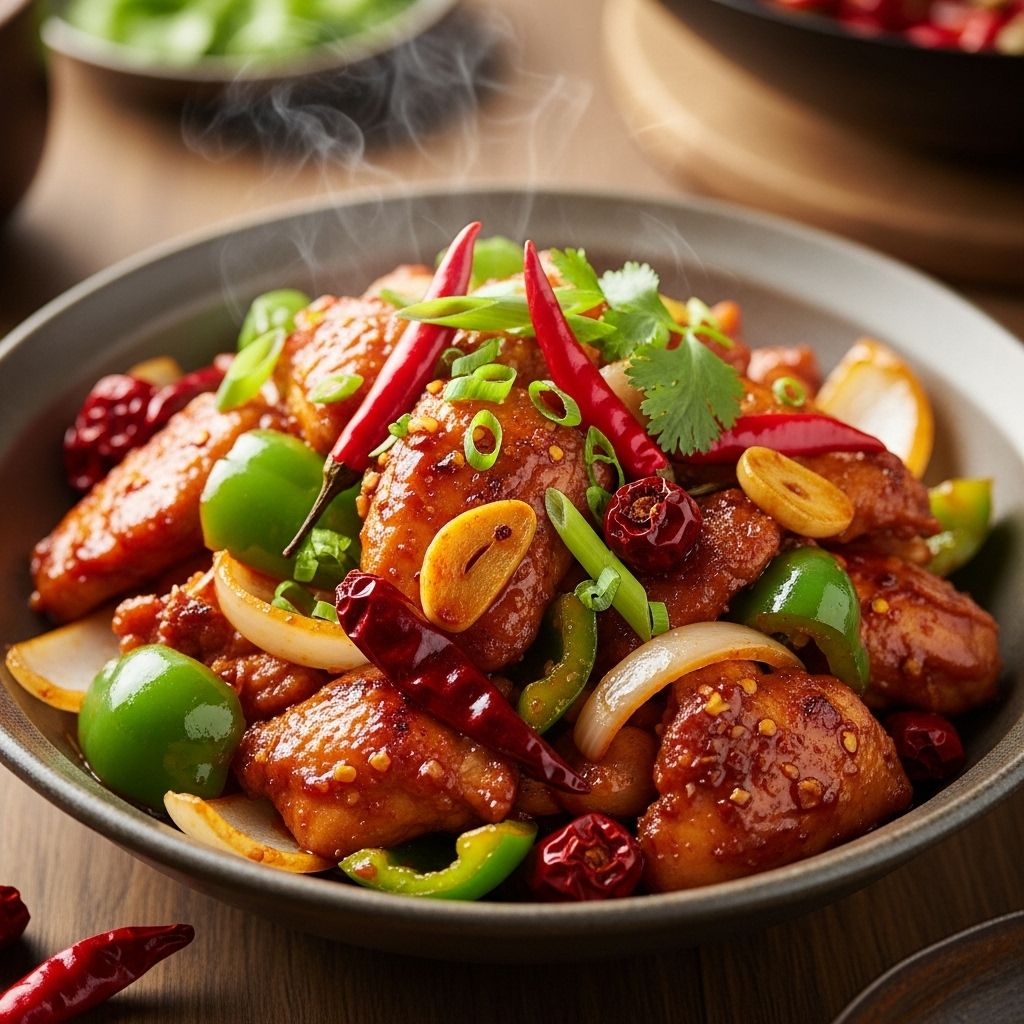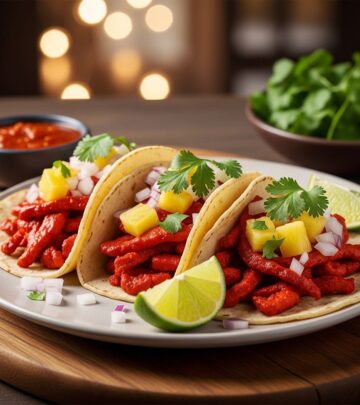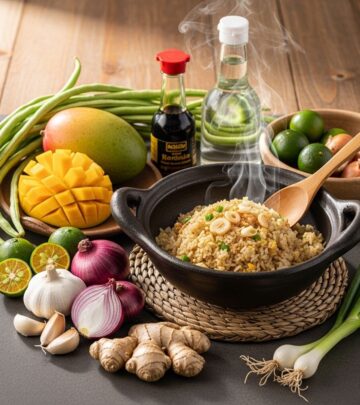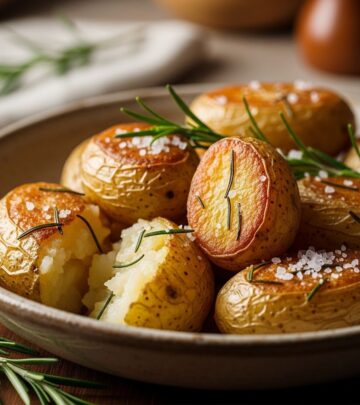Authentic Hunan-Style Chicken: A Spicy Stir-Fry Experience
Tender chicken and crisp vegetables come together in a vibrant sauce that delivers a satisfying kick.

Image: HearthJunction Design Team
Hunan-Style Chicken: A Guide to Spicy Chinese Comfort
Hunan-style chicken brings together bold flavors and colorful vegetables, creating a spicy stir-fry that’s both deeply satisfying and easy to prepare at home. This classic dish is defined by its use of fresh aromatics, hot peppers, and a savory, slightly sweet sauce, all tossed with tender pieces of chicken. The result is a meal that captures the vibrant spirit of Hunanese cuisine and is perfect for anyone craving Chinese takeout-level flavor with a homemade touch.
Table of Contents
- About Hunan-Style Chicken
- Key Ingredients
- Step-by-Step Preparation
- Tips and Variations
- Serving Suggestions
- Nutrition Information
- Frequently Asked Questions
About Hunan-Style Chicken
Known for its intense heat, robust flavors, and rustic preparation, Hunan-style chicken (also called Xiang chicken) is a staple in Chinese home kitchens and restaurant menus around the world. Unlike its milder cousin, Szechuan chicken, Hunan dishes rely less on numbing peppercorns and more on fresh hot chilies, ginger, and garlic to create layers of heat and fragrance. The typical Hunan sauce is a harmonious blend of salty, spicy, and slightly sweet notes, making it a favorite for anyone who enjoys bold Chinese fare.
The heart of this dish is the stir-fry: a fast-cooking technique that keeps the chicken juicy while vegetables stay crisp-tender. Its authentic flavors are easily achieved at home with the right ingredients and methods.
Key Ingredients
Every element in Hunan-style chicken adds aroma, flavor, or texture. Here’s an overview of what you’ll need for a classic preparation:
| Ingredient | Purpose & Notes |
|---|---|
| Chicken breast or thighs | Cut into bite-sized pieces. Thighs are juicier, breasts are leaner. |
| Soy sauce | For savory depth and color. Both light and dark soy sauces may be used. |
| Chinese wine (sherry or Shaoxing) | Adds complexity; dry sherry is a common substitute. |
| Honey or sugar | Balances the heat with subtle sweetness. |
| Bean sauce (doubanjiang or black bean sauce) | Provides salty, umami-rich flavor and authentic aroma. |
| Fresh ginger and garlic | Essential aromatics for punch and fragrance. |
| Scallions | Adds freshness and color. |
| Chili peppers (fresh or dried) | Delivers the signature Hunan heat; adjust to taste. |
| Bell peppers, mushrooms, other vegetables | Optional for color, crunch, and balance. |
| Chicken broth or water | Used to make the sauce. |
| Oyster sauce (optional) | Adds extra umami and sheen to the sauce. |
| Cornstarch or potato starch | To thicken the sauce and give the chicken a tender coating. |
| Cooking oil | For high-heat stir-frying; vegetable or peanut oil recommended. |
Ingredient Substitutions
- Chicken thighs can be swapped for chicken breast if you prefer a leaner texture.
- If you can’t find Chinese bean sauce, use Korean doenjang or black bean garlic sauce as alternatives.
- Shaoxing wine may be replaced with dry sherry or mirin in a pinch.
- For milder heat, use red bell pepper in place of some hot chilies.
Step-by-Step Preparation
Preparing Hunan-style chicken at home is straightforward. Here is a step-by-step process to achieve restaurant-quality results:
1. Marinate the Chicken
- Cut the chicken into uniform pieces for even cooking.
- In a bowl, toss the chicken with soy sauce, Chinese wine, ginger, garlic, and a bit of cornstarch.
- Let it marinate for at least 20 minutes. This step infuses the meat with flavor and ensures a tender texture.
2. Prepare the Sauce
- In a small mixing bowl, combine soy sauce, honey (or sugar), Chinese bean sauce, oyster sauce (if using), and chicken broth or water.
- Stir well to dissolve any pastes or sugar. Set this mixture aside.
3. Prepare the Vegetables
- Slice bell peppers, mushrooms, and chilies into bite-sized pieces.
- Mince or slice ginger, garlic, and scallions as needed.
4. Stir-Fry the Chicken
- Heat a wok or large skillet over high heat. Add a few tablespoons of oil.
- When the oil is shimmering, add the marinated chicken. Spread it out in a single layer and leave undisturbed for a minute to brown.
- Stir-fry until the chicken is golden and just cooked through. Remove and set aside.
5. Cook the Aromatics and Vegetables
- In the same wok, add a touch more oil if necessary.
- Add garlic, ginger, and sliced chilies. Stir-fry for 30 seconds until fragrant.
- Add bell peppers, mushrooms, and any other vegetables. Stir-fry until crisp-tender, about 2 minutes.
6. Combine and Finish
- Return the chicken to the wok. Give the prepared sauce a quick stir and pour it in.
- Stir-fry briskly on high heat to combine everything; the sauce should thicken and coat the chicken and vegetables.
- Finish with scallions and adjust seasoning as needed.
7. Serve
- Immediately plate the stir-fry, serving it hot alongside steamed white rice.
- Garnish with a few extra sliced chilies or scallions if desired.
Tips and Variations
- Use high, even heat: The key to great stir-fry is a very hot pan and quick cooking to preserve the crunchiness of vegetables and tenderness of chicken.
- Mix up the vegetables: Try adding snap peas, broccoli, or baby corn for variety and texture.
- Make it vegetarian: Substitute tofu or mushrooms for chicken for a satisfying meatless dish.
- Adjust heat to taste: Control the spiciness by varying the type and amount of chili peppers used.
- Double the sauce: For extra saucy stir-fry, simply increase the sauce ingredients proportionally.
Serving Suggestions
- Steamed white rice is the classic pairing, absorbing all the delicious sauce.
- For a healthier option, serve with brown rice or quinoa.
- Pair with light side dishes like cucumber salad or steamed greens to balance the heat.
- Enjoy leftovers cold for a next-day lunch, as the flavors intensify overnight.
Nutrition Information
Hunan-style chicken is high in protein and offers a balance of fiber, vitamins, and minerals when packed with vegetables. Key points to consider:
- Using chicken breast yields a lighter dish; thighs provide extra moisture and flavor.
- Control sodium by using reduced-sodium soy sauce and rinsing canned bean sauces if desired.
- For fewer calories, lessen the amount of oil and sugar in the recipe.
| Nutrient | Approximate Value (per serving) |
|---|---|
| Calories | 350-400 kcal |
| Protein | 24-30g |
| Fat | 16-18g |
| Carbohydrates | 22-25g |
| Sodium | 900-1100mg |
*Values are estimates and will vary based on specific ingredients used and portion sizes.
Frequently Asked Questions (FAQs)
Q: Can I make Hunan chicken less spicy?
A: Yes. Simply reduce the number of chili peppers or use milder varieties. You can also omit chili oil or dried red chilies altogether for a gentle heat .
Q: What is the difference between Hunan and Szechuan chicken?
A: Hunan chicken uses fresh chilies and garlic for heat, resulting in a simpler, more direct spiciness, while Szechuan chicken features Szechuan peppercorns for a numbing sensation and often incorporates more complex sauces .
Q: Can I prepare this dish in advance?
A: The dish is best fresh, but you can prep the chicken and sauce ahead of time. Store separately and stir-fry just before serving for optimal texture.
Q: Are there gluten-free options?
A: Yes. Use tamari or coconut aminos instead of soy sauce, and confirm that the bean sauce and oyster sauce are gluten-free, as some brands may add wheat .
Q: What if I can’t find bean sauce?
A: Substitute with a mixture of miso and a splash of soy sauce, or use more oyster sauce for a slightly different but still savory flavor.
Related Recipes
- Hunan Kung Pao: Adds shrimp, Sichuan peppercorns, and bell peppers for a twist on the classic Hunan flavor .
- Simple Szechuan Chicken: Try for a milder or more numbing version with peppercorns.
- Vegetarian Hunan Stir-Fry: Use tofu and a variety of mushrooms for a fully plant-based meal.
Conclusion
Making authentic Hunan-style chicken at home is a delicious way to experience the intense, rustic, and spicy flavors of Chinese cuisine. With a handful of pantry staples, fresh aromatics, and vibrant vegetables, this stir-fry can be tailored to suit any spice level or dietary preference. Serve it up with fluffy rice and enjoy how each bite brings the tastes of Hunan to your table.
References
Read full bio of Shinta












